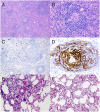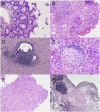TAFRO Syndrome in Caucasians: A Case Report and Review of the Literature
- PMID: 29018798
- PMCID: PMC5614916
- DOI: 10.3389/fmed.2017.00149
TAFRO Syndrome in Caucasians: A Case Report and Review of the Literature
Abstract
Background: TAFRO syndrome has been reported in Japan among human herpesvirus 8 (HHV-8)-negative/idiopathic multicentric Castleman's disease (iMCD) patients. To date, the majority of iMCD patients with TAFRO syndrome originate from Japan.
Case presentation: Herein, we report a 67-year-old HIV/HHV-8-negative Caucasian iMCD patient diagnosed with TAFRO. He presented with marked systemic inflammation, bicytopenia, terminal renal insufficiency, diffuse lymphadenopathies, and anasarca. Lymph node and bone marrow biopsies revealed atrophic germinal centers variably hyalinized and megakaryocytic hyperplasia with mild myelofibrosis. Several other biopsies performed in kidneys, liver, gastrointestinal tract, prostate, and lungs revealed unspecific chronic inflammation. The patient had a complete response to corticosteroids, tocilizumab, and rituximab. He relapsed twice following discontinuation of rituximab. When reviewing the literature, we found seven other Caucasian cases with TAFRO syndrome. There were no significant differences with those described by the Japanese cohort except for the higher frequency of kidney failure and auto-antibodies in Western patients.
Conclusion: This case illustrates that patients with TAFRO syndrome can develop non-specific inflammation in several tissue sites. Furthermore, this case and our review of the literature demonstrate that TAFRO syndrome can affect Caucasian and Japanese patients highlighting the importance of evaluating for this syndrome independently of ethnic background.
Keywords: Castleman–Kojima disease; Caucasian; TAFRO; multicentric Castleman’s disease; review of literature.
Figures




References
-
- Soulier J, Grollet L, Oksenhendler E, Cacoub P, Cazals-Hatem D, Babinet P, et al. Kaposi’s sarcoma-associated herpesvirus-like DNA sequences in multicentric Castleman’s disease. Blood (1995) 86:1276–80. - PubMed
Publication types
LinkOut - more resources
Full Text Sources
Other Literature Sources

